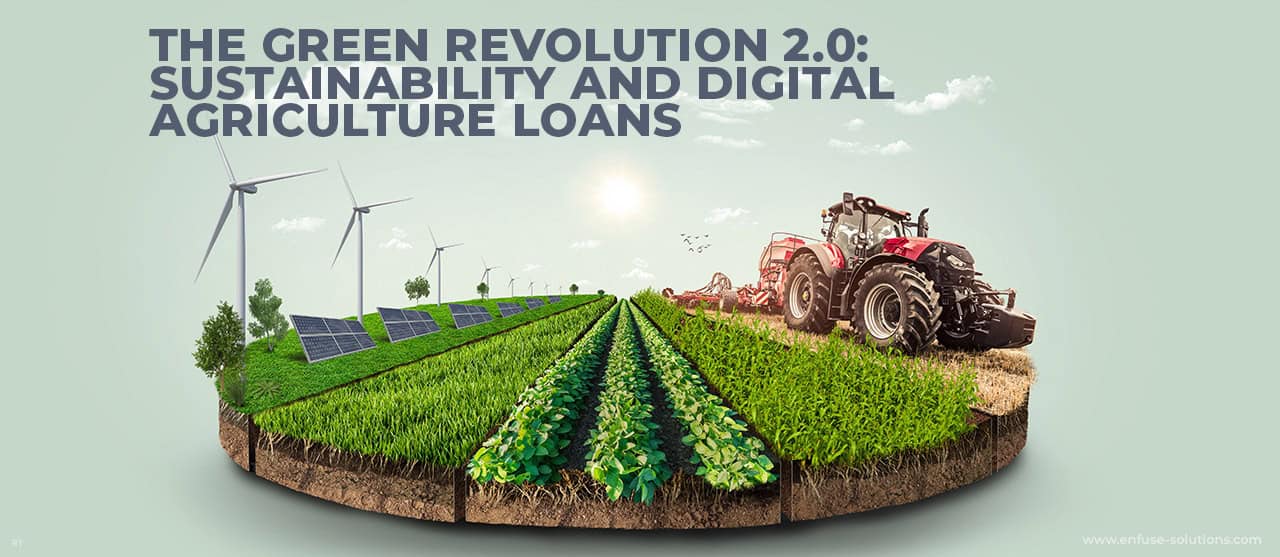
The world is at the cusp of a new era in agriculture, one that is driven by both sustainability and digital innovation. As global concerns about climate change and environmental degradation escalate, the agricultural sector finds itself at the forefront of the battle for a more sustainable future. In this context, the marriage of digital agriculture loans with sustainable farming practices heralds the dawn of what we can aptly term the “Green Revolution 2.0.”
In this blog post, we delve into the symbiotic relationship between digitalized loan data and sustainable agriculture, exploring how this dynamic duo can propel us toward a more environmentally and socially conscious future.
Digital Agriculture Loans: A Catalyst For Change
1. Efficiency And Accessibility
Digital agriculture loans are reshaping the landscape of farming finance, offering unprecedented efficiency and accessibility. Farmers can now apply for loans, receive approvals, and manage their finances with a few clicks on their smartphones or computers. This not only streamlines the loan process but also empowers farmers, especially small and marginal ones, who might have faced barriers in accessing traditional financial services.
2. Data-Driven Decision Making
The heart of digital agriculture loans lies in data. By leveraging advanced analytics and data processing technologies, financial institutions can gain deep insights into the agricultural landscape. This data-driven approach enables them to assess risk more accurately, tailor loan products to farmers’ needs, and make informed lending decisions. As a result, the agricultural sector benefits from a more efficient allocation of financial resources, fostering sustainability at its core.
3. Customized Loan Products For Sustainable Practices
One of the significant advantages of digital agriculture loans is the ability to customize products based on the specific needs of farmers engaged in sustainable practices. Whether it’s investing in precision agriculture, organic farming, or water-efficient irrigation systems, these loans can be tailored to support initiatives that align with environmental and social goals. This flexibility encourages farmers to adopt more sustainable methods, ultimately contributing to the broader goals of ecological conservation.
Sustainability And Environmental Impact
1. Precision Agriculture
Digital agriculture loans pave the way for the widespread adoption of precision agriculture, an approach that utilizes technology to optimize farming processes. From satellite-guided tractors to IoT-enabled sensors, precision agriculture minimizes resource use by precisely targeting inputs like water, fertilizers, and pesticides. By funding such practices, digital loans become catalysts for sustainable agriculture, reducing environmental impact while maximizing productivity.
2. Climate-Resilient Farming
Climate change poses unprecedented challenges to agriculture, with unpredictable weather patterns and extreme events becoming more frequent. Digital agriculture loans can finance climate-resilient farming practices, such as the adoption of drought-resistant crops, improved water management systems, and climate-smart technologies. These investments not only protect farmers from the adverse effects of climate change but also contribute to a more sustainable and resilient agricultural ecosystem.
3. Promoting Agroecology
Agroecology, an ecological approach to farming, emphasizes the integration of ecological principles into agricultural systems. Digital agriculture loans can support farmers transitioning to agroecological practices by providing funds for agroforestry, cover cropping, and diversified crop rotations. These initiatives enhance soil health, biodiversity, and overall ecosystem resilience, fostering a more sustainable and regenerative form of agriculture.
Social Impact And Inclusivity
1. Empowering Smallholder Farmers
Digital agriculture loans are crucial in empowering smallholder farmers, who often face challenges in accessing formal financial services. By providing them with digital financial tools and access to credit, these loans enable small farmers to invest in sustainable practices, breaking the cycle of poverty and contributing to inclusive economic growth.
2. Gender-Inclusive Financing
Gender inclusivity is a key aspect of sustainable development in agriculture. Digital agriculture loans can be designed to address the specific financial needs of women farmers, who form a significant portion of the agricultural workforce. By providing gender-inclusive financing options, these loans promote equality and empower women to play a more active role in sustainable agricultural practices.
Conclusion
The Green Revolution 2.0 is not just a vision; it’s a tangible reality unfolding through the convergence of sustainability and digital innovation in agriculture. Digital agriculture loans, with their capacity to efficiently process data and customize financial products, are at the forefront of driving this revolution. By aligning financial incentives with sustainable practices, these loans have the power to transform agriculture into a force for positive environmental and social change.
As we move forward, it is imperative for financial institutions, policymakers, and the agricultural community to collaborate in creating a supportive ecosystem for digital agriculture loans. This includes investing in digital infrastructure, promoting financial literacy among farmers, and designing policies that incentivize sustainable farming practices.
In embracing the Green Revolution 2.0, EnFuse Solutions secures the future of agriculture and contributes to a more sustainable and resilient planet for generations to come. The integration of digital agriculture loans with sustainable practices is not just an evolution; it’s a revolution that holds the promise of a greener, more inclusive, and socially responsible agricultural landscape.

















Comment